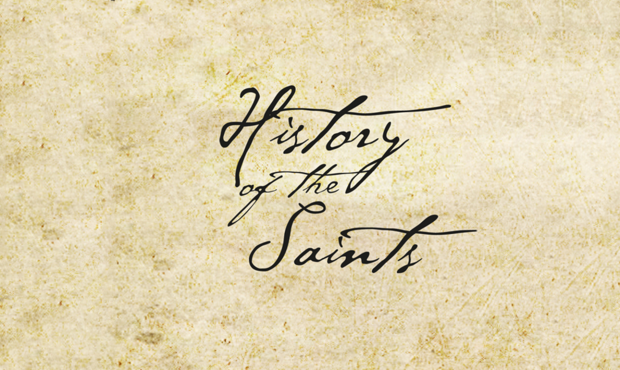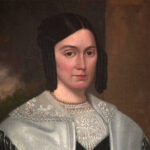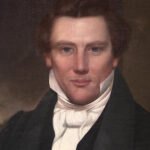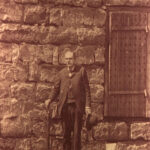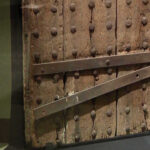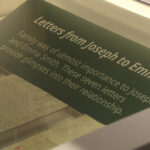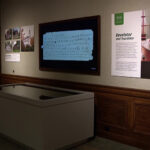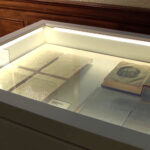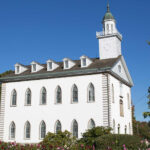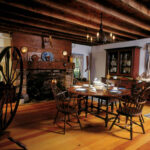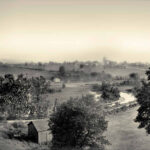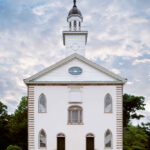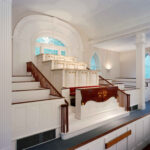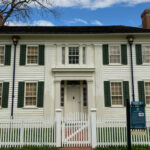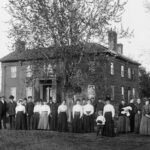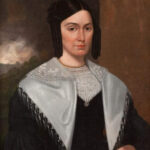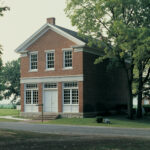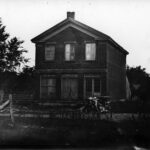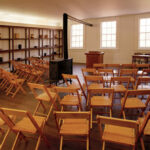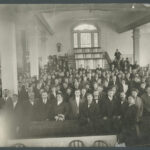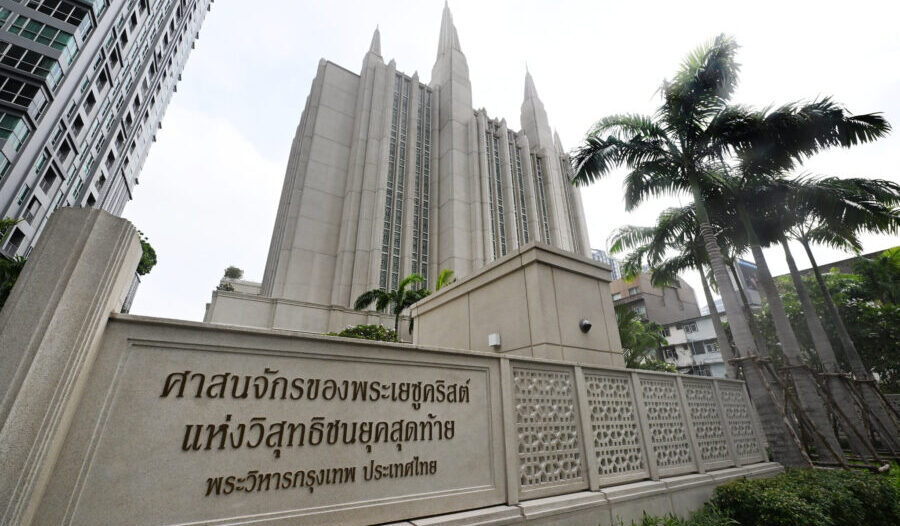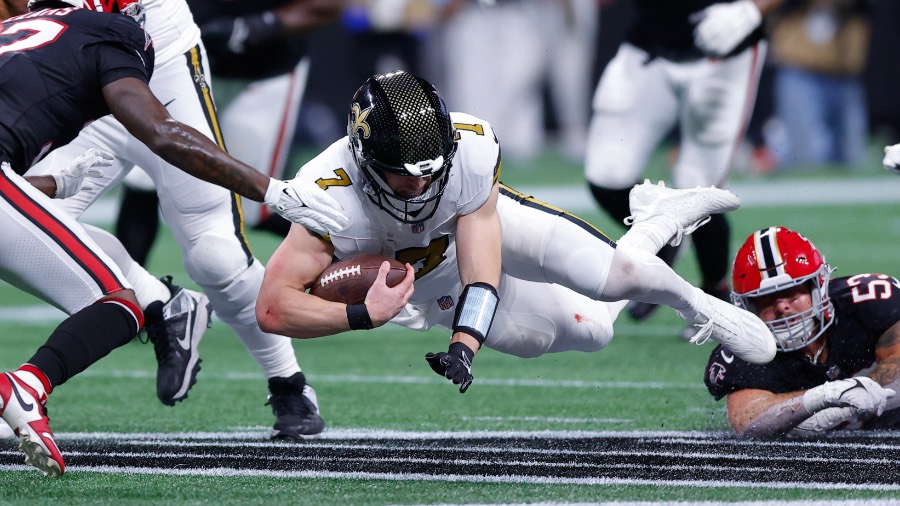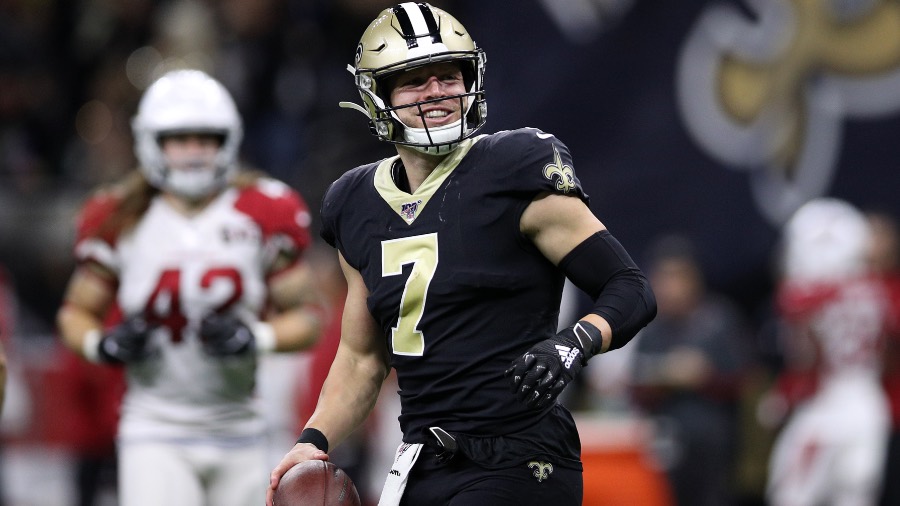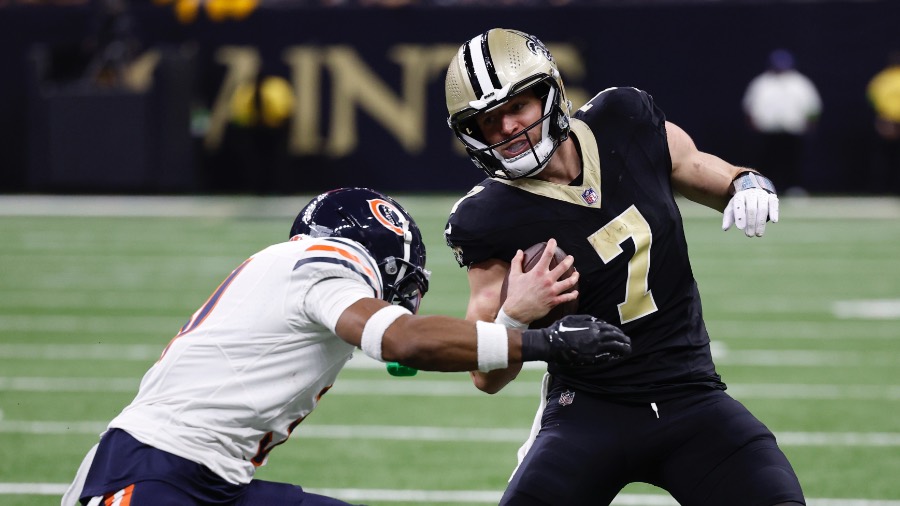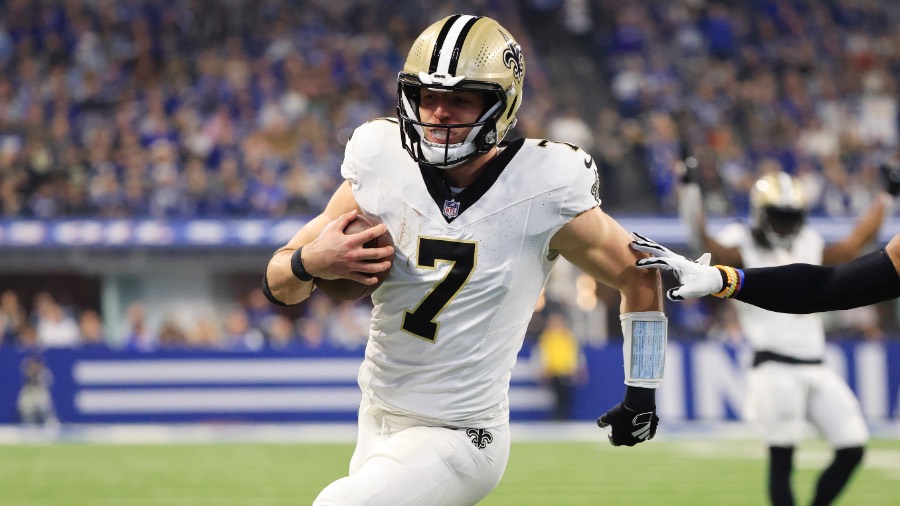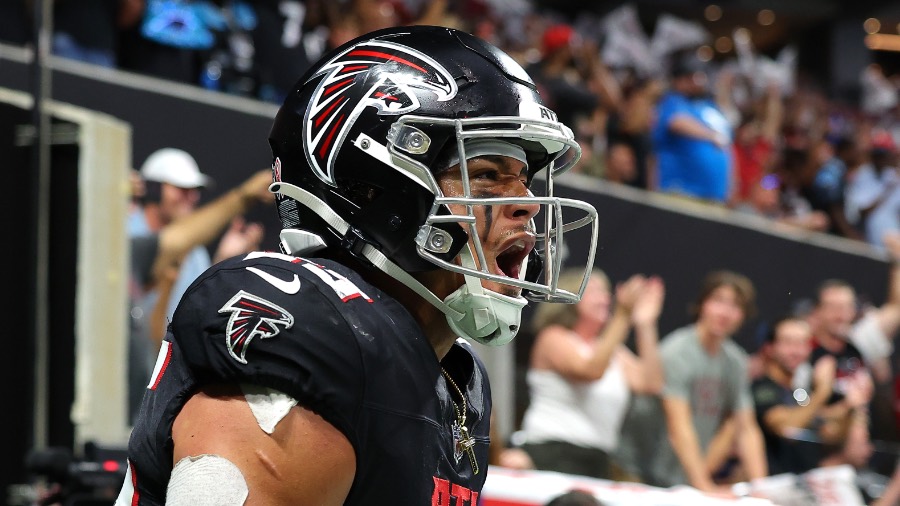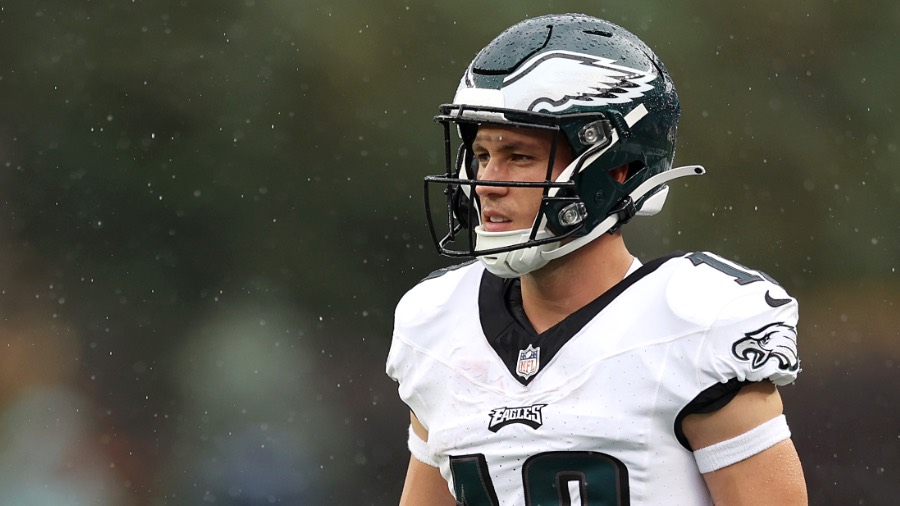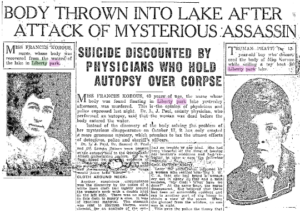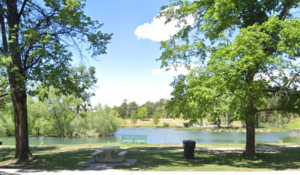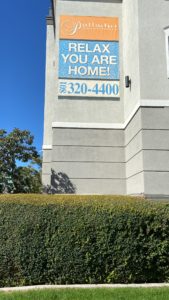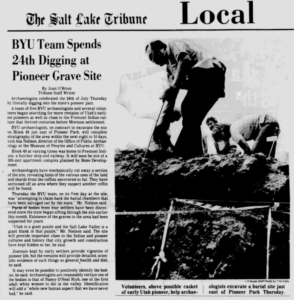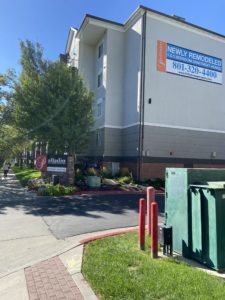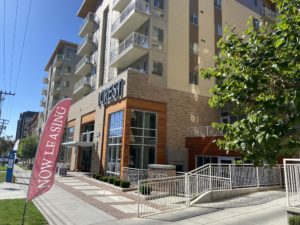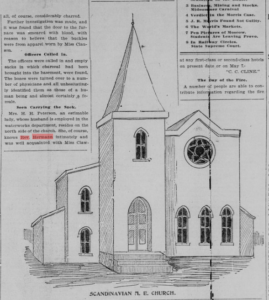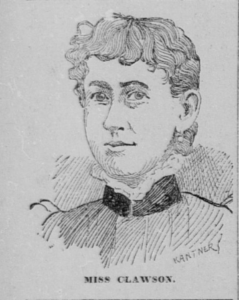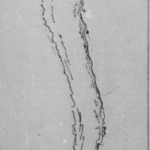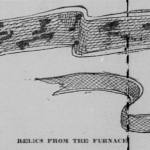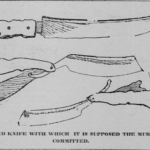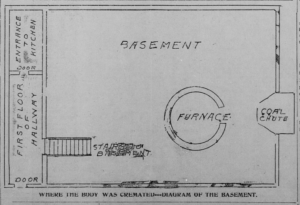This History of the Saints special presentation tells the story of the martyrdom of Joseph and Hyrum Smith on June 27, 1844. Using documents and material from volume 15 of The Joseph Smith Papers project, historians share context about the events that led up to the day, and what happened in the aftermath.
This brief look at history allows you to experience Joseph’s final theological sermon, his final devotional address to the Latter-day Saints, and excerpts from the last heartfelt letters he wrote to his wife Emma before his death.
Video: History of the Saints (October 2023)
This History of the Saints special presentation tells the story of the martyrdom of Joseph and Hyrum Smith on June 27, 1844. Using documents and material from volume 15 of The Joseph Smith Papers project, historians share context about the events that led up to the day, and what happened in the aftermath. This brief look at history allows you to experience Joseph’s final theological sermon, his final devotional address to the Latter-day Saints and excerpts from the last heartfelt letters he wrote to his wife Emma before his death.
In Sept. 1823, Moroni appeared to the Prophet Joseph Smith and the marvelous work and a wonder began.
As we approach the 200th anniversary of that event, what have we learned about the situation of the Smith family, and the Prophet Joseph Smith in particular, in 1823, just preceding Moroni’s appearance?
Many relevant and important details about those foundational events have come to light through the efforts of dedicated historians.
This History of the Saints special presentation shares what we have learned.
History of the Saints: The Doctrine & Covenants
What is the Doctrine and Covenants, how did it come to be, and what is its role in the Lord’s work? This is the timely and important subject of this special presentation of History of the Saints. President Benson said in April 1987 “God bless us all to use all the scriptures, but in particular the instrument He designed to bring us to Chris—the Book of Mormon, the keystone of our religion—along with its companion volume, the capstone, the Doctrine and Covenants, the instrument to bring us to Christ’s kingdom, The Church of Jesus Christ of Latter-day Saints.”
General Conference Documentaries
You can watch all of the General Conference documentaries like this on the KSL-TV app. The app is free with no cable subscription required. And it’s available for a variety of smart TV and smartphone platforms including Amazon Fire, Roku, iOS, Android and fourth-generation Apple TV boxes.
History of the Saints: The Joseph Smith Papers
The Joseph Smith Papers
The Joseph Smith Papers are a wealth and treasure of understanding. It is one of the most significant historical works of our generation. In History of the Saints, church historians talk about how many volumes have been released and more are coming in the years ahead. All of this work serves to affirm the faith of the Saints. Just released is the newest volume in the Documents Series—Documents Volume 9. It is different than previous volumes because of the short span of time it covers and is a wealth of information. If you have had questions about the origins of the Relief Society, or Joseph Smith as a Mason, or of the Prophet’s many and varied roles of leadership in Nauvoo—then this program will be of great help to you.
General Conference Documentaries
You can watch all of the General Conference documentaries like this on the KSL-TV app. The app is free with no cable subscription required. And it’s available for a variety of smart TV and smartphone platforms including Amazon Fire, Roku, iOS, Android and fourth-generation Apple TV boxes.
Video: The Church of Jesus Christ of Latter-day Saints opens new exhibit in Church History Museum
The Church of Jesus Christ of Latter-day Saints opened a new exhibit in the Church History Museum Monday, which will be open to the public until Oct. 26.
SALT LAKE CITY – The Church History Museum opened a new interactive exhibition to teach children about temples that will be in place during the renovation of the Salt Lake Temple. Also on Wednesday, Church officials released “Saints” volume 2.
The new book focuses on building temples in the West and addresses several more difficult periods in Latter-day Saint Church history.
“One of the things we’re trying to do with ‘Saints’ is to tell a global history of the Church,” said Matthew Grow, director of publications for The Church of Jesus Christ of Latter-day Saints. Grow oversaw the team of writers for this project.
“Saints” volume 2 covers Latter-day Saint history from 1846 to 1893, discussing the trek West, immigrants who strengthened the faith and Native Americans who helped the Saints. The complete title is “Saints: No Unhallowed Hand.”
Saints, Volume 2: No Unhallowed Hand
Grow said all four volumes have titles from Joseph Smith’s Wentworth Letter, explaining the faith to a journalist in 1843.
“There was a great effort in the second half of the 1800s of the American government (and) other people who opposed the Latter-day Saints and what they were trying to establish in Utah,” Grow said.
As with the first volume, this one focuses on some well-known individuals, such as Brigham Young.
Grow said Young was tough but was also accessible to the Saints.
“They didn’t call him President Young. They called him Brother Brigham, and there’s a great significance in that,” Grow said. “They believed that Brigham was one of them, that he knew them. He took time to understand their concerns, to answer their letters, to sit and counsel with them.”
Readers will also find the story of his daughter, Susa Young Gates. Gates was a suffragist, but struggled with an abusive husband, divorce, and child custody.
Grow said the story of “Saints” includes tragedy and mental illness – everything we experience today. The volume also tells the story of plural marriage.
“It’s one of the most difficult things for us to understand; it’s just so foreign to our own sensibilities,” Grow said. “But one of the things we tried to highlight is that they were engaged in plural marriage because of their faith.”
Grow said of those who practiced polygamy, some succeeded as families, while others did not. Many people also faced challenges and tests of faith when the Manifesto to end polygamy was issued in 1890.
The Mountain Meadows Massacre is also referenced in the volume.
In 1857, a Mormon militia slaughtered more than 120 members of a wagon train from Arkansas in southern Utah. Grow said this was a difficult chapter to write and read.
“When they were pushing their own agendas, when they were trying to save themselves or their own reputations, trying to cover up the bad decisions they’d already made, that’s when it got more and more tragic,” Grow said.
“Saints” volume 2 features the building of temples in the West – St. George, Manti, and Logan, and ends with the iconic structure in Salt Lake.
Grow said the writers did not know about the closing of the Salt Lake Temple for a seismic upgrade, but he believes readers will enjoy the history.
“So, there is this really interesting timing, all the things going on with the temple today and we have the back story in ‘Saints,’” said Grow.
‘Temples Dot The Earth’ Exhibit
Speaking of timing, a new children’s exhibit called “Temples Dot the Earth” debuted at the Church History Museum.
It begins with a painting of a young Jesus leaving the temple in Jerusalem with his parents then moves to a world map where children can identify countries and temple locations.
The brightly painted rooms have toys and activities for younger children, like stacking a spire and topping it with an Angel Moroni. For older children, there are computer games about temples, building Solomon’s temple and what happens in temples versus meetinghouses.
“We felt it was so important to learn through creative play, through activities, through artifacts about the temple and about why we build temples, why we attend temples, and why they’re so central to our faith,” said Maryanne Stewart Andrus, exhibits and education supervisor. Andrus was a team leader on the project, which took two-and-a-half years to complete.
There is history to learn in the exhibit as well, with temple artifacts.
“We’ve got some tools that were used in the design of the Nauvoo Temple,” said curator Alan Morrell. “All of the Utah temples are represented. We have some carpet from the Logan Temple.”
Part of the exhibit looks like a temple interior with an interactive model. Children can pick up a cardboard-backed photograph, each one representing a temple room somewhere in the world, and then slide it into an area of the model to make it 3-D.
Alan and Maryanne said they hope that families will enjoy the exhibit together as well as invite their friends of other faiths.
Both the book’s writers and exhibition curators said they hope each will provide the Saints with greater understanding and faith.
“Saints” volume 2 is now available as a book, online, and as an audiobook in 14 languages. The children’s temple exhibition will be at the Church History Museum for the next four years.
Saints Church History
Church History
Discover stories from Church archives that are seldom heard. The new Saints Church history volumes share a unique perspective on the history of The Church of Jesus Christ of Latter-day Saints. The story-telling style allows for the discovery of how the early church was formed and what the Saints experienced in those early years. This documentary takes you behind the scenes of the creation of these new books. Meet the historians and scholars associated with these works and hear why these history books are written in a more narrative form.
General Conference Documentaries
You can watch all of the General Conference documentaries like this on the KSL-TV app. The app is free with no cable subscription required. And it’s available for a variety of smart TV and smartphone platforms including Amazon Fire, Roku, iOS, Android and fourth-generation Apple TV boxes.
SALT LAKE CITY — The Church of Jesus Christ of Latter-day Saints unveiled a new exhibit Monday at the Church History Museum after a display of unique artifacts took a trip to Utah from Independence, Missouri.
The exhibit opened at 10 a.m. on Monday and will remain open until Oct. 26. Staff working there said seeing it in person helps them connect to the past and bring some of the history to life.
Church History Museum Director Laura Paulson Howe said the exhibit begins with portraits of Joseph Smith and Emma Smith. The paintings set the tone for the entire experience, and really all other portraits of the two. She said the portraits also mark their relationship together as rare companion portraits.
“All of the things we recognize (in) portraits of Joseph (like) the high collar, the neatly tied cravat of Emma, that embroidered chemise that she wears … this is what we see over and over in everything coming out,” Howe said. “These are the portraits upon which all other portraits of Joseph and Emma are based. They’re one of very few portraits that were done from life.”
Across the room, documents are neatly organized.
“This is one of the earliest attempts to write the history of the Church,” Spencer W. McBride, a historian with the Joseph Smith Papers said.
McBride said when church leaders could not get a hold of that record in 1837, they started a new church history, which is the one Latter-day Saints know best today. Sharing these pieces of history with others is something McBride cherishes.
“As historians, it’s very exciting to see it in person; have access to it in person, to do the research we need with the original documents,” McBride said.
Another display, behind glass, includes the original door from Liberty Jail, where Joseph Smith and five others were imprisoned.
“Some very important revelations come out of that experience. Joseph writes them in a letter from Liberty Jail,” said Riley M. Lorimer, director of the Church History Museum.
The door is a direct visual of some of the hardships the church’s earliest leaders endured, Lorimer said.
“As long as memory lasts, will remain in my mind the great creaking of the hinges as it closed upon the noblest men on earth,” Lorimer said, quoting the words of a visitor of Liberty Jail during Joseph Smith’s imprisonment.
Contributing: Mary Culbertson, KSL TV
From 4-leaf clovers to some unexpected history, all you need to know about St. Patrick’s Day
NEW YORK (AP) — If it’s March, and it’s green, it must be St. Patrick’s Day.
The day honoring the patron saint of Ireland is a global celebration of Irish heritage. And nowhere is that more so than in the United States, where parades take place in cities around the country and all kinds of foods and drinks are given an emerald hue.
In fact, it was among Irish American communities that the day became the celebration it is, from its roots as a more solemn day with a religious observance in Ireland.
But even in America, it was about more than a chance to dye a river green (looking at you, Chicago) or just bust out a favorite piece of green clothing, it was about putting down roots and claiming a piece of the country’s calendar.
Who is St. Patrick and why does he even have a day?
Patrick was not actually Irish, according to experts. Born in the late fourth century, he was captured as an adolescent and ended up enslaved in Ireland. He escaped to another part of Europe where he was trained as a priest and returned to Ireland in the fifth century to promote the spread of Christianity.
Several centuries later, he was made a saint by the Catholic Church and like other saints had a day dedicated to him, which was March 17th. He became Ireland’s patron saint, and even when religious strife broke out between Catholics and Protestants, was claimed by both, says Mike Cronin, historian and academic director of Boston College Dublin.
How did an Irish saint’s day become an American thing?
The short answer: Irish people came to America and brought their culture with them. St. Patrick’s Day observances date back to before the founding of the U.S., in places like Boston and New York City. The first parade was held in Manhattan in 1762.
While the day was marked with more of a religious framing and solemnity in Ireland until well into the 20th century, in America it became the cultural and boisterous celebration it is today, marked by plenty of people without a trace of Irish heritage.
It was because people in Ireland started seeing how the day was marked in the U.S. that it became more of a festival in the country of its origin rather than strictly a religious observance, Cronin says, pointing to the parades, parties and other festivities that are held.
Oh, and by the way, for those who like to shorten names: Use St. Paddy’s Day, not St. Patty’s Day. Paddy is a nickname for Pádraig, which is the Irish spelling of Patrick.
Why is it such a big deal to celebrate a holiday like this?
Holidays aren’t simply days to watch bands go by, or wear a specific outfit or costume.
Being able to mark a holiday, and have others mark it, is a way of “putting down roots, showing that you’ve made it in American culture,” says Leigh Schmidt, professor in the Danforth Center on Religion and Politics at Washington University. “You’ve made your claim on that American calendar, in American civic life, by having these holidays widely recognized.”
The spread of St. Patrick’s Day celebrations in the U.S. was a way for Irish immigrant communities, who in the 19th century faced discrimination and opposition, to stake that ground, he says: “It’s a kind of immigrant Irish way of combating nativist antagonism against them.”
What’s with four-leave clovers, anyway?
A popular sight around the holiday is the shamrock, or three-leaf clover, linked to Ireland and St. Patrick.
The lucky ones, though, come across something that’s harder to find: a four-leaf clover. That’s because it takes a recessive trait or traits in the clover’s genetics for there to be more than the normal 3 leaves, says Vincent Pennetti, a doctoral student at the University of Georgia’s College of Agricultural and Environmental Sciences. He has been fascinated by the plants since high school.
Four-leaf clovers “are real. They are rare,” he says.
That doesn’t mean they can’t be found. People just have to keep their eyes open and “get really good at noticing patterns and breaks in the patterns, and they just start jumping out at you,” he says.
Katie Glerum finds them. The 35-year-old New York City resident says it’s not unheard of for her to be somewhere like Central Park and see one. She usually scoops it up and often gives it to someone else, to a positive response.
“If it happened every day, then I probably would be less excited about it,” she says. “But yeah, when it happens, it is exciting.”
SALT LAKE CITY — The Church of Jesus Christ of Latter-day Saints announced it purchased the Kirtland Temple and several other historic buildings and artifacts from the Community of Christ for an agreed-upon amount.
According to a release from the Church, discussions leading to this agreement began in June 2021.
“This exchange of assets is significant for our church,” Stephen M. Veazey, president of Community of Christ, said. “Through funding from increased endowments, Community of Christ will have greater capacity to pursue our mission priorities around the world, including continuing to fulfill the divinely envisioned purposes for our Temple in Independence, Missouri.”
The Church now takes responsibility and ownership for several historic buildings in Nauvoo, the Kirtland Temple, and various manuscripts and artifacts officially transferred from the Community of Christ.
“We are deeply honored to assume the stewardship of these sacred places, documents, and artifacts,” said Russell M. Nelson, President of The Church of Jesus Christ of Latter-day Saints. “We thank our friends at Community of Christ for their great care and cooperation in preserving these historical treasures thus far. We are committed to doing the same.”
Together, we share an interest in and reverence for these historic sites and items and are committed to preserving them for future generations.
The release stated “The Kirtland Temple will remain an historic building. The Church of Jesus Christ of Latter-day Saints plans to reopen it March 25, 2024, for public tours at no charge. Likewise, in Nauvoo, the Smith Family Homestead, the Mansion House and the Red Brick Store will also reopen on March 25, 2024, for year-round public tours at no charge.”
Further details and information about the agreement will be “forthcoming,” the Church stated.
The Church said the historic transfer indicates the long-standing effort to preserve religious and cultural heritage.
The Church also included a page of frequently asked questions with additional information included below:
Today, Community of Christ and The Church of Jesus Christ of Latter-day Saints announced the transfer of significant historical properties and artifacts related to the restoration of the gospel of Jesus Christ. The following answers address frequently asked questions about the details of the transaction and future plans for the historic sites and artifacts.
1. What was included in the transaction?
The transaction involves land, buildings, artifacts, and documents. The real estate, along with some artifacts, are in Kirtland, Ohio, and Nauvoo, Illinois, while artifacts and documents also come from Community of Christ Library and Archives in Independence, Missouri.
2. What are the most significant items?
The most significant properties are the Kirtland Temple, the Smith Family Homestead, the Mansion House, the Nauvoo House, and the Red Brick Store. Significant documents and artifacts include manuscripts and the Bible used in the Joseph Smith Translation of the Bible, seven letters from Joseph Smith to his wife Emma, John Whitmer’s history of the Church, original portraits of Joseph and Emma Smith, the cornerstone of the Nauvoo House, the original door of Liberty Jail, and a document with the title of “Caractors,” which may contain a sample of inscriptions from the gold plates. (See the appendix for a more detailed list of items transferred.)
3. How did Community of Christ acquire these materials?
After the Saints left Kirtland in the 1830s, different parties controlled access to the temple over the years. In 1901, Community of Christ, then known as the Reorganized Church of Jesus Christ of Latter Day Saints (“RLDS Church”) secured title to the Kirtland Temple through legal proceedings. The Smith family properties in Nauvoo remained in possession of Emma Smith after Joseph Smith’s death and she and her children eventually joined the RLDS Church. Thereafter, the properties passed through family connections to the RLDS Church. Other documents and artifacts were donated to the RLDS Church archives by their individual owners.
4. Why did Community of Christ sell these materials now?
As Community of Christ President Stephen M. Veazey noted in the joint statement, the transfer of materials at this time enables their mission and priorities around the world.
5. Why did The Church of Jesus Christ of Latter-day Saints purchase these materials?
The sites and artifacts in this transaction relate to significant events and people in the Restoration of the gospel of Jesus Christ.
6. What is the relationship between the two churches?
The two churches enjoy a strong, respectful, and friendly relationship. For many decades, we have collaborated on numerous historical and humanitarian projects.
7. Have there been previous transactions of historic materials between the two churches?
Yes. In 2012, Community of Christ sold to the Church of Jesus Christ several properties, including the Hawn’s Mill Massacre site and the Joseph and Emma Smith home in Kirtland. Five years later, Community of Christ sold the Printer’s Manuscript of the Book of Mormon to the Church of Jesus Christ.
8. What was paid for the properties, artifacts, and documents?
The Church paid US$192.5 million without assigning specific values to the properties and items.
9. Will the historic sites be open to the public?
Yes. The historic buildings in Kirtland and Nauvoo closed on March 5, 2024, to facilitate the transfer of ownership and will reopen to the public on March 25, 2024. Tours will be provided of the Kirtland Temple, the Smith Family Homestead, the Mansion House, and the Red Brick Store. Updated visitor information will be published on the historic site webpages for Historic Kirtland and Historic Nauvoo.
10. Will admission be charged to visit the sites?
No. All of the Church of Jesus Christ’s historic sites are open to the public at no charge.
11. Will members of Community of Christ continue to have access to the sites?
Yes. The sites will be open to the public generally. The Church has also made specific arrangements with Community of Christ to allow for special meetings and gatherings over the coming years.
12. Will the Kirtland Temple be converted into a functioning Latter-day Saint temple?
No. The Kirtland Temple will be maintained and presented as a historic building that is open to the public. President Russell M. Nelson announced a temple in Cleveland in April 2022, and the Church released its site address in December 2022 and a rendering in July 2023.
13. Will the Church continue to pursue development of its proposed new visitors’ center near the Nauvoo Temple?
Yes. The proposed visitors’ center in Nauvoo will orient visitors to the historic and contemporary significance of the Nauvoo Temple. The use of the other two visitors’ centers in Nauvoo will be determined in the future.
List of Items Transferred
Smith Family Homestead and Summer Kitchen, 935 South Main Street
Joseph and Emma Smith Mansion House, 890 South Main Street
Red Brick Store (reconstructed), 610 Water Street
Nauvoo House, 950 South Main Street
Historical Artifacts
Original door of Liberty Jail, circa 1833
Book of Mormon “Caractors” document
Four pages from Revelation Book 1, including portions of revelations now known as Doctrine and Covenants 64, 65, 66, 76, 81, and 133
Seven letters from Joseph to Emma Smith, including letters written on 13 October 1832, 18 May 1834, 4 November 1838, 12 November 1838, 9 November 1839, 23 June 1844, and 27 June 1844
A history of the church, written by John Whitmer
Manuscript notes of an 1879 interview with Emma Smith by Joseph Smith III
Joseph Smith’s printed “Phinney” Bible (Cooperstown, New York, 1828) with his numerous markings as part of the Joseph Smith Translation of the Bible
Manuscripts of the Joseph Smith Translation of the Bible:
Old Testament manuscript 1 (June 1830–7 March 1831)
Old Testament manuscript 2, first part (8 March–5 April 1831)
Old Testament manuscript 2, second part (20 July 1832–2 July 1833)
Old Testament manuscript 3 (ca. late 1830–early 1831)
New Testament manuscript 1 (8 March–June 1831)
New Testament manuscript 2, Folio 1 (4 Apr 1831–26 Sep 1831)
New Testament manuscript 2, Folio 2 (26 Sep 1831–late 1831)
New Testament manuscript 2, Folio 3 (winter 1831–1832)
New Testament manuscript 2, Folio 4 (January/February 1832–31 July 1832)
Publication committee manuscripts for the first complete edition of the Joseph Smith Translation of the Bible as The Holy Scriptures (1867)
Joseph Smith writing desk (Kirtland Temple)
1820s couch associated with the Whitney family (Kirtland Temple)
Original elements of the Kirtland temple:
Oval window frame
Front door keystone and frame
Stone arch
Windows
Pieces of original stucco and sandstone
Nauvoo Temple Sunstone
Two Nauvoo Temple Moonstones
Nauvoo House cornerstone, which housed the Original Manuscript of the Book of Mormon
Joseph Smith desk (Mansion House)
Emma Smith trunk (Mansion House)
Lucy Mack Smith rocking chair (Mansion House)
Two Smith family chairs (Mansion House)
Emma Smith walking stick (Homestead)
Washstand associated with Hawn’s Mill (Homestead)
Sampler (Homestead)
Bowl (Homestead)
Three inkwells (Red Brick Store)
In addition, the transfer includes the vast majority of representative period artifacts that are currently on display in the historic buildings (most of these artifacts are not historically associated with the Smith family or with Nauvoo).
Non-Historic Buildings in Kirtland
Temple Visitor’s Center, 9076 Chillicothe Road
Private residence and shop, 7788 Maple Street
Private residence, 7799 Joseph Street
Private residence, 9120 Timothy Lane
Small Undeveloped Lots in Kirtland
[unnumbered] Joseph Street
9080 Chillicothe Road
Historic Buildings with Modernized Interiors in Nauvoo (Private Use)
Hiram and Thankful Clark home, 790 Soth Hyde Street
Aaron and Polly Johnson home, 475 Water Street
William and Rosannah Marks home, 575 Water Street
Sidney and Phebe Rigdon home, 860 South Main Street
Jonathan and Rebecca Wright home, 455 Water Street
The First Hotel, 795 South Main Street
A stone stable built by Lewis Bidamon, 940 South Main Street
Non-Historic Buildings in Nauvoo
Maintenance Shop, Bain Street
All Nauvoo Blocks and Lots (indexed to the 1842 Map of the City of Nauvoo)
Block 137, Lot 4 – no structures
Block 138 – no structures
Block 139, lots 3-4 – includes the First Hotel
Block 140, lots 3-4 – no structures
Block 145 – no structures
Block 146 – includes the Joseph Smith Historic Site Visitor’s Center (initially leased by the Church and subject to a secondary closing at a later date), James and Sally Brinkerhoff former home site, and Levi and Clarissa Hancock former home site
Block 147 – includes the Mansion House, Rigdon home, Clark home, Samuel and Levira Smith former home site, and Theodore and Frances Turley former home site
Block 148 – includes the William Law store former site
Block 149 – includes the Marks home, public restrooms, a Hyrum Smith office former site, and the Times and Seasons newspaper office former site
Block 150 – includes the Johnson home, Wright home, maintenance shop
Block 153 – no structures
Block 154 – includes a Hyrum Smith office former site
Block 155 – includes the Red Brick Store and the Smith Homestead and summer kitchen; does not include the Smith Family Cemetery
Block 156 – includes the Nauvoo House, Bidamon stable, Joseph Smith red brick stable former home site, Joseph Sr. and Lucy Smith former home site, Porter Rockwell former home site, and a parking area
Block 157 – no structures
Block 158, lots 2-3 – includes private residence (960 South Partridge Street)
Block 161 – no structures
Block 162 – no structures
SALT LAKE CITY — The Church of Jesus Christ of Latter-day Saints announced it will open a new missionary training center in Bangkok, Thailand, in 2024.
The new MTC will open in January to help accommodate the training of new full-time missionaries who are from Southeast Asia and other regions. It will be built in the annex of the new complex surrounding the Bangkok Thailand Temple, which was dedicated and opened in October.
This will be the Church’s 10th MTC, with other locations in Brazil, England, Ghana, Mexico, New Zealand, Peru, the Philippines, South Africa and Provo, Utah.
Latter-day Saint missionaries spend three to nine weeks in training at an MTC (those not learning a foreign language stay at an MTC for up to three weeks) before departing for one of the Church’s missions. Currently, over 72,000 missionaries are serving worldwide, and the Church will open 36 new missions on July 1, bringing the total number to 450 — the highest number in Church history.
“MTCs provide a decidedly more rigorous curriculum rooted in gospel fundamentals. The meat and drink of MTC life is daily practice teaching situations, intense gospel classroom instruction from teachers who are former missionaries, weekly devotional addresses from Church leaders and MTC staff, and weekly service opportunities,” Church officials said.
Saints QB Taysom Hill Powers Into End Zone For Touchdown Against Lions
SALT LAKE CITY – Former BYU Cougars quarterback Taysom Hill fought his was across the goal line for a touchdown during the Week 13 NFL game between the New Orleans Saints and Detroit Lions.
Taysom Hill finds paydirt in Week 13
The Saints hosted the Lions at Caesars Superdome in New Orleans, Louisiana on Sunday, December 3.
RELATED: Saints QB Taysom Hill Makes NFL History With Touchdown Catch Against Bears
With 4:34 left in the third quarter, Hill took a direct snap and burst forward into a pile of players before powering his way into the end zone. Hill’s one-yard touchdown run cut Detroit’s lead to 24-21.
.@T_Hill4 finds the end zone for his fourth rushing touchdown of 2023.#LocalsInTheNFL #NFL #DETvsNO #Saints #BYUFOOTBALL @kslsports pic.twitter.com/zqhzaLbaEz
— Kyle Ireland (@kyleireland) December 3, 2023
The score capped a seven-play, 62-yard drive that took 3:37.
Hill entered the game with 57 carries for 287 yards and three touchdowns on the ground this season. The Saints came into the game with a 5-6 record.
New Orleans’ game against Detroit is broadcast on FOX and NFL Sunday Ticket.
About Taysom Hill
Prior to his NFL career, the Idaho native was a quarterback at BYU. Hill played for the Cougars from 2012-16.
During his college career, Hill threw for 6,929 yards, 43 touchdowns, and 31 interceptions. He ran for 2,815 yards and 32 touchdowns.
After going undrafted, Hill signed a free agent deal with the Green Bay Packers. Before the regular season, Hill was waived by the Packers and picked up by the Saints. Since then, Hill has become a key piece of New Orleans’ offense.
.@T_Hill4 x2
The former @BYUfootball quarterback finds paydirt for the second time today.#LocalsInTheNFL #NFL #Saints #NOvsIND #BYUFOOTBALL @kslsports pic.twitter.com/ODdmZJYrS3
— Kyle Ireland (@kyleireland) October 29, 2023
During his NFL career, Hill has played multiple positions, including quarterback, running back, wide receiver, and tight end.
Kyle Ireland is a Sports Producer and Locals in the NFL Insider for KSLSports.com. He’s also co-host of the Yards After College Podcast. Follow him on X/Twitter (@kyleireland), Instagram (@kyleirelandksl), and Threads (@kyleirelandksl).
Instant Replay: Taysom Hill Makes Impressive Catch During Saints’ Week 12 Game
SALT LAKE CITY – Former BYU Cougars quarterback Taysom Hill made an impressive reception during the Week 12 NFL game between the New Orleans Saints and Atlanta Falcons.
Taysom Hill makes great catch in Saints-Falcons game
The Falcons hosted the Saints at Mercedes-Benz Stadium in Atlanta, Georgia on Sunday, November 26.
With 3:50 remaining in the opening quarter, Saints quarterback Derek Carr floated a ball toward the sideline before Hill went up and snatched the ball out of the air for a 36-yard gain to the Falcons’ 19-yard line.
What a catch by, @T_Hill4. #LocalsInTheNFL #NFL #Saints #BYUFOOTBALL @kslsports pic.twitter.com/GEJY82buaq
— Kyle Ireland (@kyleireland) November 26, 2023
The drive ended up resulting in a pick-six for the Falcons.
Atlanta won the contest by a score of 24-15.
Hill finished the contest with seven carries for 26 yards and two catches for 55 yards. Hill entered the Week 12 game having recorded 22 receptions for 159 yards and one touchdown this season. He’d also run the ball 50 times for 261 yards and three touchdowns and thrown for 72 yards and a touchdown this season.
With the loss, the Saints dropped to a 5-6 record this season. New Orleans’ next game is at home against the Detroit Lions on Sunday, December 3 at 11 a.m. (MT) on FOX.
About Taysom Hill
Prior to his NFL career, the Idaho native was a quarterback at BYU. Hill played for the Cougars from 2012-16.
During his college career, Hill threw for 6,929 yards, 43 touchdowns, and 31 interceptions. He ran for 2,815 yards and 32 touchdowns.
After going undrafted, Hill signed a free agent deal with the Green Bay Packers. Before the regular season, Hill was waived by the Packers and picked up by the Saints. Since then, Hill has become a key piece of New Orleans’ offense.
— Kyle Ireland (@kyleireland) November 5, 2023
During his NFL career, Hill has played multiple positions, including quarterback, running back, wide receiver, and tight end.
Hill has scored 47 total touchdowns during his NFL career.
Kyle Ireland is a Sports Producer and Locals in the NFL Insider for KSLSports.com. He’s also co-host of the Yards After College Podcast. Follow him on X/Twitter (@kyleireland), Instagram (@kyleirelandksl), and Threads (@kyleirelandksl).
Saints QB Taysom Hill Has Jersey Put In Pro Football Hall Of Fame
SALT LAKE CITY – After putting his name in the NFL record books two weeks ago, Saints QB Taysom Hill had his jersey set up in the Pro Football Hall of Fame.
Hill isn’t the first player with local ties to receive that honor this season. Colts kicker Matt Gay and Rams wide receiver Puka Nacua also had their jerseys set up in Canton, Ohio this year.
🗣️ New to the Pro Football Hall of Fame
The jersey, wristband & shoes that @T_Hill4 of the @Saints wore in Week 9, when he joined Frank Gifford as the only players in NFL history with at least 25 rushing, 10 passing & 10 receiving TDs.
Full Story: https://t.co/33MKeMtWYu pic.twitter.com/4rfoyMNm5E
— Pro Football Hall of Fame (@ProFootballHOF) November 14, 2023
Against the Chicago Bears in week nine, Hill became the first NFL player to score 10 or more touchdowns in rushing, passing, and receiving since Frank Gifford hit the mark in 1957.
RELATED: Saints QB Taysom Hill Makes NFL History With Touchdown Catch Against Bears
Gifford played for the New York Giants from 1952-60, 1962-64. He finished his career with 14 passing touchdowns, 34 rushing touchdowns, and 43 receiving touchdowns. He hit the mark of 10 touchdowns in all three categories during the 1957 season.
Taysom Hill is the first @NFL player to have at least 10 career:
rushing TDs
passing TDs
receiving TDssince @ProFootballHOF member Frank Gifford! pic.twitter.com/aJxBF4zS6B
— New Orleans Saints (@Saints) November 5, 2023
Hill entered the game with 10 passing touchdowns, 26 rushing touchdowns, and nine passing touchdowns.
Later in the game, Hill connected with Juwan Johnson for his first touchdown pass of the season.
The Saints held off the Bears for a 24-17 win.
.@T_Hill4 continues to tear it up.
Hill hits Juwan Johnson for his first touchdown pass of the season.#LocalsInTheNFL #NFL #Saints #CHIvsNO #BYUFOOTBALL @kslsportspic.twitter.com/7k3qIdStdJ
— Kyle Ireland (@kyleireland) November 5, 2023
About Taysom Hill
Prior to his NFL career, the Idaho native was a quarterback at BYU. Hill played for the Cougars from 2012-16.
During his college career, Hill threw for 6,929 yards, 43 touchdowns, and 31 interceptions. He ran for 2,815 yards and 32 touchdowns.
After going undrafted, Hill signed a free agent deal with the Green Bay Packers. Before the regular season, Hill was waived by the Packers and picked up by the Saints. Since then, Hill has become a key piece of New Orleans’ offense.
Former @BYUfootball QB @T_Hill4 breaks free for a @Saints touchdown, his second rushing score in as many weeks.#LocalsInTheNFL #NFL #Saints #NOvsIND #BYUFOOTBALL @kslsports pic.twitter.com/ws6TWQuQhC
— Kyle Ireland (@kyleireland) October 29, 2023
During his NFL career, Hill has played multiple positions, including quarterback, running back, wide receiver, and tight end.
Hill has scored 44 total touchdowns during his NFL career.
Are you on Threads yet? Let’s connect, give us a follow @kslsports.
Chandler Holt is a co-host for the Jazz Notes podcast and a Digital Sports Producer for KSLSports.com, specializing in all things basketball and football. Follow Chandler on Twitter @ChandlerHoltKSL or on Threads @chandlerho1t.
Take us with you, wherever you go.
The Church of Jesus Christ of Latter-day Saints announces 36 new missions
SALT LAKE CITY — The Church of Jesus Christ of Latter-day Saints announced the creation of 36 new missions in 2024 to accommodate the rising number of missionaries. The number of missionaries is now at over 72,000.
According to a release from The Church, the new missions will open on July 1, 2024, putting the total number of missions at 450 — the highest number in Church history.
Breaking: @Ch_JesusChrist announcing 36 new missions .. including 3 new ones in Utah. Second largest increase of new missions in one year. This will happen July 1, 2024. Total worldwide will jump to 450 missions worldwide. @KSL5TV
— Dan Rascon (@TVDanRascon) November 1, 2023
Elder Quentin L. Cook of the Quorum of the Twelve Apostles chairs the Church’s Missionary Executive Council.
“We are incredibly grateful for the response we have seen by so many young people to our beloved Prophet’s clarion call for missionary service in April of last year,” Elder Cook said. “We are witnessing an increased enthusiasm for sharing the gospel of Jesus Christ throughout the world. These new missions, spread all around the world, will be a blessing locally as we desire to have more missionaries supporting the units of the Church.”
Leaders will create the missions from existing missions. The Church said the new missions will allow more missionaries to serve within wards and branches and have more interactions with mission leaders.
“This is a big announcement. This is something we should celebrate,” Elder Ronald A. Rasband of the Quorum of twelve apostles said. “Prior to this announcement, five or six stakes might share one set of missionaries. With this announcement, we’re going to have at least one companionship of missionaries to every stake in Utah. That’s never happened before. What does it mean for a local family, a local ward in Utah, it means that they can finally get closer to one set of missionaries.”
The number of missionaries has increased significantly over the past two years. The number of total missionaries has gone from 56,000 at the end of 2021, to 62,500 at the end of 2022, to 72,00 in 2023. Approximately 5,300 of those missionaries are senior missionaries.
In a policy update, now prospective missionaries can submit their missionary recommendations up to 150 days prior to their availability date instead of 120 days. This change gives prospective missionaries more time to prepare for their missions, shortens the period between a prospective missionary’s availability date and mission start date, and reduces visa delays for missionaries assigned to serve outside their home countries.
The new missions will be in the following locations:
Africa Central
- Democratic Republic of the Congo Kinshasa South
- Democratic Republic of the Congo Kolwezi
- Kenya Nairobi East
Africa South
- Madagascar Antananarivo North
Africa West
- Ghana Accra North
- Ghana Takoradi
- Nigeria Calabar
- Nigeria Port Harcourt North
- Sierra Leone Bo
Asia
- Cambodia Phnom Penh East
- Thailand Bangkok East
Asia North
- Japan Sendai
Brazil
- Brazil Manaus South
Caribbean
- Dominican Republic Santo Domingo North
Europe Central
- Germany Hamburg
Europe North
- Portugal Porto
México
- México Mexicali
- México Puebla East
North America Central
- Montana Missoula
North America Southeast
- Florida Tallahassee
- South Carolina Charleston
North America Southwest
- Nevada Henderson
- Texas Dallas South
- Texas El Paso
North America West
- California Modesto
Philippines
- Philippines Dumaguete
- Philippines General Santos
- Philippines Tuguegarao
South America Northwest
- Bolivia Cochabamba South
- Ecuador Quito West
- Perú Lima Northeast
South America South
- Argentina Tucumán
- Chile La Serena
Utah
- Utah Salt Lake City East
- Utah Saratoga Springs
- Utah Spanish Fork
Looking Back At History Of BYU-Texas Football Series
PROVO, Utah – One man brought the BYU/Texas football series to life in 1987.
That man was Lou Holtz.
You’re probably thinking, wait, THAT Lou Holtz? Yes, the former Notre Dame headman and your favorite former ESPN analyst, Lou Holtz.
Before Holtz was at Notre Dame, he was the head coach at Minnesota. He took the head post in Minneapolis after a seven-year stint in Arkansas in the winter of 1984.
Holtz’s first line of business as the head coach of the Gophers was to lighten up future schedules. Two of those teams that he wanted to remove from Minnesota’s future schedules were BYU and Texas.
Minnesota had home-and-homes with BYU and Texas for the 1987 and 1988 seasons.
The Longhorns and Cougars suddenly needed games. Texas AD DeLoss Dodds and BYU AD Glen Tuckett came together and brought together a series that no one ever expected to happen.
Since 1987, BYU and Texas have met five times on the football field. This Saturday will be the sixth and likely final meeting these two programs ever have against each other. It will be a memorable one as it will come as two Big 12 foes.
September 12, 1987: BYU 22, Texas 17
Texas Memorial Stadium (Austin, Texas)
The first-ever meeting saw BYU roll into Austin with Bob Jensen at quarterback and escape with a victory over the Longhorns. BYU’s defense produced a big performance, producing a sack in the third quarter. Kicker Leonard Chitty had a pair of field goals and BYU came away with the five-point win.
September 8, 1988: BYU 47, No. 19 Texas 6
Cougar Stadium (Provo, Utah)
BYU rolled through Texas in Provo. The Longhorns star tailback Eric Metcalf was suspended for taking money for a summer school session before the game kicked off. Imagine that sort of suspension in today’s college football.
Anyway, Sean Covey was dealing to the tune of 323 yards as BYU got a signature win over a mediocre Texas squad.
September 10, 2011: Texas 17, BYU 16
Darrell K. Royal-Texas Memorial Stadium (Austin, Texas)
Often forgotten in this game is that BYU had a 13-0 lead in the second quarter. BYU’s offense, which was revamped with Brandon Doman as offensive coordinator, struggled out of the gates with the increase of competition on an Independent schedule.
Texas rolled with Garrett Gilbert at quarterback, then had Case McCoy and David Ash play in the game. Despite having three different QBs, the Longhorns squeaked out their lone victory over BYU.
September 7, 2013: BYU 40, No. 15 Texas 21
LaVell Edwards Stadium (Provo, Utah)
Thunderstorms delayed what would be a monsoon of rushing yards from BYU against a lifeless Texas team. Less than four years after playing for the National Championship, Texas coach Mack Brown unofficially saw his tenure come to an end in Provo.
Taysom Hill rushed for 259 yards and Jamaal Williams popped off another 182 in BYU’s “Go Fast, Go Hard” offense that left Texas defensive coordinator Manny Diaz with a pink slip the following day.
September 6, 2014: BYU 41, Texas 7
Darrell K. Royal-Texas Memorial Stadium (Austin, Texas)
BYU is well aware of big-name opponents downplaying their effort level against the Cougars after losses. Did they want to be there? That sort of thing.
There was no question Texas wanted to get revenge for what happened against BYU the year before. The September 2014 issue of Texas Monthly featured new Texas head coach Charlie Strong with Texas AD Steve Patterson. On the cover, the headline read, “Can a new athletics director and a new attitude return UT to glory? (Or at least beat BYU?)”
Taysom Hill had other plans.
The hurdle from Hill is one of the iconic moments in BYU football’s history.
Hill rushed for 134 and passed for 181, accounting for three touchdowns as BYU steamrolled Texas again.
October 28, 2023: BYU at No. 7 Texas
Darrell K. Royal-Texas Memorial Stadium (Austin, Texas)
Win or lose on Saturday for BYU, the Cougars should thank the Longhorns before they leave Austin. Without Texas getting antsy and wanting to leave for the SEC, BYU isn’t in the Big 12.
That’s the ultimate victory for BYU.
But one last time in Austin as conference foes should make for an entertaining stage.
Date: Saturday, October 28, 2023
Location: Darrell K. Royal-Texas Memorial Stadium
Kickoff: 1:30 p.m. (MT)
TV: ABC
Radio: KSL NewsRadio (102.7 FM, 1160 AM) — Extended pregame coverage begins at 9 a.m.
Mitch Harper is a BYU Insider for KSLsports.com and host of the Cougar Tracks Podcast (SUBSCRIBE) and Cougar Sports Saturday (Saturday from 12–3 p.m.) on KSL Newsradio. Follow Mitch’s coverage of BYU in the Big 12 Conference on X and Threads: @Mitch_Harper.
Take us with you wherever you go.
Trevor Lawrence Comes Through Late, Jaguars Hold Off Saints
NEW ORLEANS (AP) — Jacksonville quarterback Trevor Lawrence was playing with a sprained left knee, and the visiting Jaguars hurt their own cause with turnovers and penalties.
Jaguars beat Saints in Week 7
They were still good enough to overcome that and pull out a dramatic victory that extended their winning streak to four games.
Travis Etienne ran for two touchdowns, Foyesade Oluokun returned an interception for a score, and Christian Kirk’s late 44-yard touchdown after a short catch over the middle lifted the Jaguars to a 31-24 victory over the New Orleans Saints on Thursday night.
“I don’t think I’ve run that fast since college,” said Kirk, a former Texas A&M star, whose late score made up for his lost fumble in the first half. “That was some vintage stuff. I’m glad I was able to do it in that moment.”
Lawrence returned from the knee injury that forced him out of the final minutes of a victory over Indianapolis on Sunday and wound up leading Jacksonville (5-2) with 59 yards rushing.
“It’s crazy how you have something like that going on and don’t plan on moving a lot, and you end up running the ball more than you usually do,” Lawrence said. “It felt pretty good. It didn’t bother me too much and definitely didn’t set it back. That was the goal, to play, find a way to win the game and not set it back.”
The @Jaguars get a big win in The Big Easy. #TNFonPrime pic.twitter.com/QOgV1UirYX
— NFL on Prime Video (@NFLonPrime) October 20, 2023
Lawrence also completed 20 of 29 passes for 204 yards and one TD to help the Jags secure their best start since opening 5-2 in 2007.
After Kirk’s touchdown broke a 24-all tie with 3:08 left, the Saints (3-4) were in position to answer when they drove inside the Jacksonville 10 in the final minute, but stalled out with four straight incomplete passes.
Derek Carr’s third-down pass bounced off of tight end Foster Moreau’s hands in the back of the end zone and a fourth-down timing throw to Chris Olave along the left sideline fell incomplete.
The 4th down pass is incomplete and the @Jaguars are going to get the victory#JAXvsNO on Prime Video
Also available on #NFLPlus https://t.co/89nUeCngbn pic.twitter.com/s818wxCpyC— NFL (@NFL) October 20, 2023
“We’re finding it hard to start fast, finding it hard to maintain, to execute sometimes and we’re finding it hard to finish,” said Saints running back Alvin Kamara, who gained 153 yards from scrimmage on a mix of runs and catches. “That’s kind of the glaring and recurring theme.”
As time ran out, Moreau, a New Orleans native in his first season back home, looked disconsolate on the bench with his head in his hands. Teammates consoled him and later said there were too many other missed opportunities throughout the game to pin the loss on his drop.
“It doesn’t come down to one play,” Carr said. “There’s so many things that we could have done.”
Jacksonville gave the Saints numerous chances to stay in the game, losing two fumbles in the first half and committing untimely penalties throughout the game.
It almost came back to haunt them.
The Saints rallied from 24-9 down to tie the game on touchdowns by Taysom Hill on a 1-yard, fourth-down run and Michael Thomas on a 17-yard reception — the latter followed by Carr’s pass to Kamara for a 2-point conversion.
RELATED: Taysom Hill Scores First Touchdown Of Season On Thursday Night Football
.@T_Hill4 runs it in for his first touchdown of the season.#LocalsInTheNFL #NFL #Saints #JAXvsNO #BYUFOOTBALL @kslsports pic.twitter.com/SLO0eIBDFM
— Kyle Ireland (@kyleireland) October 20, 2023
Carr finished 33 of 55 for 301 yards, and New Orleans outgained Jacksonville 407 yards to 330, but the Saints again struggled to finish promising drives in the end zone after losing in a similar fashion in Week 6 at Houston.
After practicing on a limited basis this week and being listed as questionable, Lawrence completed five of his first six passes for 60 yards and even scrambled for 9 yards during a game-opening touchdown drive that ended with Etienne’s 2-yard run.
“We have to do a better job of not letting the freakin’ quarterback scramble,” Saints coach Dennis Allen said, calling Lawrence’s improvised runs a “black eye on the whole thing.”
New Orleans’ first drive ended wit Blake Grupe’s missed 51-yard field goal. But the Saints got the ball right back when Kirk was stripped by cornerback Paulson Adebo after a 19-yard catch and defensive end Carl Granderson recovered.
When New Orleans punted soon after, Jacksonville turned it over again when Tevaughn Campbell, who was trying to block, collided hard with returner Jamal Agnew as Lou Hedley’s punt descended and hit Campbell’s back.
Lonnie Johnson recovered for New Orleans, which stalled on the Jaguars 5 and settled for Grupe’s field goal.
Etienne became the first player in Jaguars history to rush for two touchdowns in three consecutive games when he ran around the left end for a 17-yard score that made it 14-3.
🅿️rimetime#JAXvsNO | #DUUUVAL pic.twitter.com/XSalWMNUYI
— Jacksonville Jaguars (@Jaguars) October 20, 2023
After their seventh third-down failure of the first half, the Saints settled for another Grupe field goal.
In the final minutes of the half, Jacksonville converted a fake punt with punter Logan Cooke completing a 13-yard pass to Tim Jones on fourth and 2, setting up Brandon McManus’ 43-yard field goal for a 17-6 halftime lead.
INJURIES
Jaguars: Safety Andre Cisco received attention on the field late in the third quarter but was able to walk off on his own.
Saints: Carr appeared to finish the game in pain, but it was not immediately clear what was ailing him. … Alontae Taylor left the game briefly in the first quarter with an apparent cut on his nose and returned for the next series.
The 5-2 Jacksonville @Jaguars pic.twitter.com/X33j8iWHB4
— NFL (@NFL) October 20, 2023
UP NEXT
Jaguars: Travel to Pittsburgh on Oct. 29.
Saints: Visit Indianapolis on Oct. 29.
Video: Sunday Edition: Pioneer Days & Church History Museum
This week on Sunday Edition, Boyd sits down with a member of the Quorum of the Twelve Apostles of The Church of Jesus Christ of Latter-day Saints, Elder D. Todd Christofferson. Together, they discuss the Days of ’47 and Pioneer Day traditions that honor our state’s history. Then he is joined by KSL’s own Carole Mikita to look at the new exhibit at the Church History Museum featuring the art of Minerva Teichert.
Sunday Edition: Pioneer Days and Church History Museum
This week on Sunday Edition, Boyd sits down with a member of the Quorum of the Twelve Apostles of The Church of Jesus Christ of Latter-day Saints, Elder D. Todd Christofferson.
Together, they discuss the Days of ’47 and Pioneer Day traditions that honor our state’s history. Then he is joined by KSL’s own Carole Mikita to look at the new exhibit at the Church History Museum featuring the art of Minerva Teichert.
KSL TV’s Dan Rascon is traveling with the Choir to Mexico City and filming a documentary on the Choir. You can follow that journey on his Twitter, Facebook and Instagram.
MEXICO CITY — For the first time in the 94-year history of “Music and The Spoken Word,” a Spanish-speaking woman will be the narrator, premiering on June 25.
The weekly half-hour broadcast with The Tabernacle Choir at Temple Square is history’s longest-running continuous network broadcasts. It’s all part of a brand new pilot program that will introduce Spanish and Portuguese speakers to serve as narrators, broadcast to Spanish and Portuguese-speaking audiences worldwide.
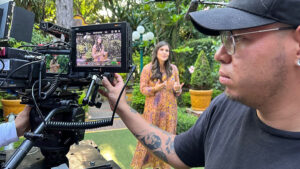
Garna Mejia, a former KSL TV news, will be one of the three other Spanish-speaking narrators. (KSL TV)
Garna Mejia, a former KSL TV news reporter who now works in the Newsroom of the Communications Department of The Church of Jesus Christ of Latter-day Saints, will join three other Spanish-speaking narrators that will rotate for the Spanish broadcast. The others include Alex Melecio, Ana Yslas, and Pepe Valle. Mejia will debut the broadcast.
“I’m thrilled, and it’s humbling,” Mejia told KSL TV. “There are so many women that have been a part of the Choir since the beginning. Something that I’m very grateful for, but something that I know I’m just a little piece in so much that came before and so much work that will continue.”
Mejia said broadcasting “Music and The Spoken Word” in Spanish will have a huge impact.
Buenos Dias from Mexico City. Today the @TheTabChoir arrives in town to kick off their World Tour. Right now crews are filming Music and the Spoken word on location. @KSL5TV pic.twitter.com/P0RPiu1Nt4
— Dan Rascon (@TVDanRascon) June 13, 2023
“The impact that can have on their lives is just unfathomable,” she said. “This is going to go into people’s homes. They are working with networks with TV stations all over Latin America. They’ve gotten something solidified in Mexico. I don’t think we will understand the ripple effect that this program is going to do. Especially when people can see someone like themselves in their own voice speaking to them, bringing them messages of hope and inspiration music that is familiar to them.”
Lloyd Newell, who has been the voice of “Music and The Spoken Word” for 33 years, said this is a huge step forward to have messages in people’s native language.
“I think this is an exciting advancement in the continuing legacy of “Music and the Spoken Word,” Newell told KSL TV. “There’s a bit of a disconnect, if you will, where they see me, and they hear a voice-over in Spanish or Portuguese or whatever the language will be. This way, we are looking at bringing native speakers who can communicate the message. It will be my spoken word, the same message just translated into various messages.”
If the Spanish and Portuguese pilot programs does well, they hope to introduce other languages as well.
The choir will arrive in Mexico City on Tuesday afternoon and perform a variety of concerts during their one-week stay. The choir will also shoot a music video and do service projects.
RELATED STORIES:
Tabernacle Choir packs their bags for 2023 world tour
‘Music and The Spoken Word’ features first Spanish-speaking woman narrator in program history
Tabernacle Choir kicks off world tour in Mexico City
In CBS’s ‘60 Minutes’ segment on church finances, it missed the sweeping rags-to-riches history of faith
SALT LAKE CITY — On Sunday night, the CBS news program “60 Minutes” aired a segment about the financial assets of The Church of Jesus Christ of Latter-day Saints. The story rehashed widely reported items about the church’s investments and spending and one man’s criticisms, a self-described “whistleblower” who once worked with church investments.
Deseret News reported that what the “60 Minutes” segment about the church’s finances and other reports often miss is the sweeping and at times poverty-ridden history that helps explain the church’s finances and decision-making today, including its modern-day record of self-sufficiency that sustains a global church.
Today, the church has a stock portfolio worth tens of billions of dollars. “60 Minutes,” said some have estimated the church’s assets total as much as $150 billion, though it didn’t provide a source for that figure. The church does not publicize how much money it has so it can keep the focus on its religious mission, Bishop W. Christopher Waddell, first counselor in the Presiding Bishopric, told “60 Minutes.”
The full article can be found here.
Celebrate Black History Month in Utah at these events
SALT LAKE CITY — Black history in the Beehive State dates back even longer than Latter-day Saint history in the area, predating the Saints’ arrival by almost 25 years.
In fact, African Americans like James P. Beckworth and Jacob Dodson were a part of fur trapping and exploratory expeditions in the Utah territory. And three Black slaves — Green Flake, Oscar Crosby and Hark Lay — were among the group that arrived in Utah with Brigham Young in 1847. Issac James, Jane Manning and their sons arrived later that year; they were the first free Black pioneers to settle in the state. By 1850, the census listed 24 “free persons of color” and 26 Black slaves in Utah.
Since those early days of settlement, Utah has had a small but vibrant Black community whose contributions have included farming and settling the Millcreek area, serving in the military at Fort Douglas and Fort Duchesne — including the country’s first Black general, Benjamin O. Davis Sr. — expanding railroads and mines in the state and establishing numerous businesses, churches and social groups like the Salt Lake and Ogden branches of the NAACP.
Today, over 50,000 Black Utahns live in the state, making up 1.5% of the population. Despite its small numbers, Utah’s Black community continues to make a large impact on the state.
Below are a number of events and resources to honor the triumphs and challenges of Black Utahns during Black History Month and beyond.
Poetic justice open mic
The Black Cultural Center, UBLAC (Utah Black Artist Collective) and the Union Programming Council are hosting an open mic night Thursday at 6 p.m. at Union Theatre in Salt Lake City. The public is invited to share their singing, poetry, comedy and other talents.
Beloved Community Project film and panel
The film “Beloved Community Project” focuses on Dr. Martin Luther King Jr.’s vision of a “beloved community” in which everyone is cared for and there is an absence of poverty, hunger and hate. The panel will discuss where America is today and will include a reenactment of a 1963 discussion between civil rights leaders about the challenges African Americans faced.
The film and panel are from 2-4 p.m. on Feb. 13, followed by a reception at the Salt Lake Community College Redwood Campus in the Technology Building Auditorium. Reserve a free ticket here.
An evening in Harlem
The Utah Black Chamber is hosting its annual gala celebrating the Harlem Renaissance — the intellectual and cultural movement within the Black community during the 1920s and ’30s. The gala is Feb. 3, 7-10 p.m. at the Ken Garff Scholarship Club in Salt Lake City. Attendees should come dressed in their best 1920s attire for an evening of food, socializing, music, dancing and casino games. Tickets are available here, and the proceeds benefit the Black Success Center.
Civil rights songs and spirituals concert
Salt Lake Community College Chamber Singers will be joined by award-winning baritone Robert Sims for a concert from 7:30-9 p.m. on Feb. 15 at the college’s South City Campus. The evening will include African American spirituals, civil rights songs and other inspiring music. Reserve a free ticket here.
Black, Bold & Brilliant film series
The Utah Film Center’s Black, Bold & Brilliant series focuses on authentic and nuanced representation through film critique and discussions led by Black Utahns. This month the center will offer showings of “Little Satchmo,” which explores the life and legacy of Louis Armstrong through his relationship with the daughter the public never knew existed. Showings are Feb. 15 at 7 p.m. and Feb. 16 at 11 a.m. The public can reserve tickets for free here.
Sip and learn about Black History
The Cocktail Collective is hosting an event focused on cocktails created by America’s Black bartenders. The event will include a hands-on cocktail lesson, take-home recipes, a light snack and a brief historical deep dive into the cocktails and their creator. Registration is available here.
Utah: Black and open for business
The Utah Black Chamber and its partners are hosting a hospitality suite and art exhibit at the Zions Bank Eagle Emporium Building in Salt Lake, Feb. 16-17 from 10 a.m. to 2 p.m. NBA All-Star Weekend attendees are encouraged to network with Utah’s Black business community and enjoy an exhibit featuring work from New York native and Utah resident Diann Harris-Wright. The event will also offer warm drinks and other programs through the chamber’s partners.
Mardi Gras in the Mountains Ball
On Feb. 18, the Leonardo Museum will transform into a Mardi Gras ball fit for New Orleans. The event will span all three floors of the museum and will include a crowning of the queen, regalia, live music and food from local Black eateries. The event is a signature event of the Utah Black Chamber. Tickets are available here.
Afro-Mexican photo exhibit
The Mexican Consulate in Salt Lake City is hosting a photo exhibit titled “Beyond the Signs” by photographer Maricela Figueroa Zamilpa, who has been documenting daily life portraits showcasing Mexico’s cultural diversity since the ’90s. The exhibit is dedicated to the Afro-Mexican peoples of the Mexican states Guerrero and Oaxaca. The exhibit is available in English and Spanish and is open during the month of February.
BYU ‘Perspectives’ show
Brigham Young University is hosting “Perspectives,” a show that “celebrates and portrays the richness and diversity that exists among and within various Black cultures in different forms such as music, dance, fashion, gospel music, poetry and life experiences with the BYU community.” The free show is Feb. 17 at 7 p.m. in the Wilkinson Student Center Ballroom on BYU’s Campus. It will also be livestreamed on BYU’s website.
WSU Black History Month speaker
Weber State University is hosting civil rights activist Fred Hampton Jr. for a free keynote address on Feb. 8, 12:30-2 p.m. at the Shepherd Union Ballrooms on campus. Hampton is the son of Black Panther Party leader Fred Hampton, who was assassinated during the civil rights movement. Hampton Jr. is also the president and chairman of the Prisoners of Conscience Committee and the Black Panther Party Cubs.
‘One Night in Miami…’ movie night
The Black Cultural Center at the University of Utah is hosting a movie night and discussion of “One Night in Miami…” on Feb. 22, 6-8 p.m. The R-rated film explores the friendship between Muhammad Ali, Malcolm X, Sam Cook and Jim Brown. Register to attend here.
Learn more about Black history in Utah
There are a number of resources about Black history in the Beehive state, such as:
- The Utah Department of Cultural and Community Engagement’s page on Utah’s African American communities
- The Utah History Encyclopedia entry on African Americans in Utah
- “African Americans and Salt Lake’s west side,” by Utah Department of Cultural & Community Engagement
- “The Utah Territory Slave Code,” by Black Past
- “The Great White Palace: African American Segregation in Utah,” by Utah Humanities
- “Utah Minorities: The Story Told by 150 Years of Census Data”
- “Black Utah: Stories from a Thriving Community” by the Utah Black Chamber
Three Salt Lake places that should be haunted based on their spooky history
SALT LAKE CITY — Forgotten graveyards, a reverend serial killer, and a Halloween mask in a lake — here are three places in Salt Lake that have particularly spooky histories. Two apartments and a local park have chilling pasts that may continue to haunt the premises.
You decide.
Rachel Quist, an archaeologist, and Fiona Robinson Hill, a historian, talked with me about some unique and lesser-known spooky histories.
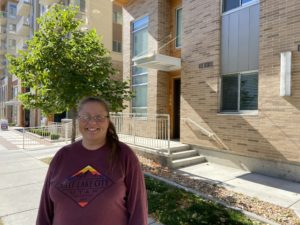
Rachel Quist, an archaeologist, shown in front of the Liberty Crest Apartments in Salt Lake City, the former location of the Scandinavian Methodist Episcopal Church.
Quist studies the history of Salt Lake extensively and has an Instagram and blog where she shares her latest findings. Robinson Hill works as a historian and enjoys leading Grimm Ghost Tours around Salt Lake City.
Liberty Park
A murder has haunted the lake at Liberty Park since 1920. The mystery surrounding 40-year-old Frances “Frae” Korous, who was believed to be murdered and then dumped in the lake, has never been solved.
A few days after Halloween, 13-year-old Truman Pratt was sailing his toy boat at the southern end of Liberty Park Lake when he saw what he believed to be a Halloween mask floating in the water about 15 feet from the shore.
Pratt fashioned a wire on a stick, and used it to pull the mask towards the shore, but once pulled closer, he realized it was attached to the body of a woman.
The Salt Lake Telegram published an interview in 1920 with Pratt who stated:
“The hook caught in what I thought was a mask, and I started to pull it ashore. It was unusually heavy, I thought, for a mask, so I was careful not to break my hold on it. When I got the object close to the shore and saw it was a body I gave a scream…”
Horrified, he ran to tell Park Superintendent, Sidney R. Lambourne, who contacted Salt Lake City Police.
The body was identified as, “Miss Frances Korous,” and was found with a white cloth tied tightly around her neck.
A native of Iowa, Korous had worked as a nurse in WWI and moved to Salt Lake City after she was discharged from the US Navy, joining her brother, Yaro, and her sister Rose. She lived at the city’s YWCA at 306 E. 300 South until she found a more permanent apartment.
The last time she was seen was the night of Sunday, Oct. 17, 1920.
That evening she attended the Methodist church and then went to visit her brother Yaro and his family for Sunday dinner. At the end of the evening, her brother escorted her to a streetcar to take back to the YWCA for the night.
Korous never made it back to YWCA and was never heard from again.
As relatives became concerned, search parties, organized by police, were organized to find her and Boy Scouts even searched in nearby canyons for the missing nurse.
Her body was recovered on Nov. 6, 1920, in Liberty Park.
When her body was found, it was discovered in the same clothing she was wearing when she disappeared with all her jewelry intact, and a watch that had stopped at 2:34.
The family of Korous denied any possibility of suicide and the coroner determined that her lungs were not full of water, and neither was her stomach, ruling that she had been killed before she was dumped in the lake.
Previously it had been believed that maybe she had been hit by a car and dragged away, but the tightly knotted rag around her neck and suspicious location of her body pointed to murder.
“The park keeper said that he had been all around the lake several times during the past few weeks. The police say that a body usually rises to the surface within at least ten days after it has entered the water.” However, Korous’ body didn’t rise to the surface until it was found by Pratt, three weeks after her disappearance.
Korous’ murder was never solved, though the lake she was found in (now more of a pond,) still exists in Liberty Park. To our knowledge, no Halloween masks have been recently spotted in the water.
The Palladio Apartments
The Palladio Apartments were built on a former cemetery for Mormon pioneers and an indigenous burial ground. It is likely, because of the rush to finish excavation and continue construction on the apartment buildings, that some remains continue to lie beneath the apartment building. And if you’re thinking, ‘isn’t that the whole premise of the movie “Poltergeist”?’ You would be right.
The remains were discovered when construction was beginning on a set of apartments that were built before the currently standing Palladio Apartments.
Construction workers were pouring the foundation for a building and found the remains, but the project was never finished as the company declared bankruptcy, the foundation was then reconfigured for the Palladio Apartments.
“I think at the time there was an idea that there was a cemetery somewhere in the area because you know you have the story of the first child dying, and that’s well before the city cemetery’s established,” Quist said.
She said there was an official archaeology report written about what they found and how they found it; newspapers at the time also covered the discovery.
However, less mentioned at the time was the presence of human remains and artifacts from Native American burials too.
“While they were digging their Mormon burials, they probably, absolutely came into contact with all sorts of artifacts. That’s the case out in Grantsville, that’s the case at Brigham City, Willard, basically everywhere that the Mormons settled they were already settling on a village site,” Quist said.
Construction was halted when formal grave sites were found. Typically, when a body is found during construction, everything is stopped and local authorities are contacted.
“The process now is you contact local law enforcement, generally the police, they then evaluate which path it goes down.”
If the remains are more recent, police begin an investigation into the identity and cause of death. If the remains are historic, archaeologists are called to look into it.
“They’ve encountered human remains with their back hoes there in the back dirt, they’ve already found the Native American remains and either didn’t notice, or didn’t care,” Quist said. “But once they found Mormon Pioneer graves in wood coffins all of a sudden, ‘We’ve got something here, we’ve got to call the authorities.’ ”
Quist explained the pioneer grave sites were obvious with coffins all facing the same direction.
“This was an established, laid out, pioneer cemetery. So everybody’s buried in roughly the same direction, in very rough lines or rows, in [coffins of] milled lumber with wood and metal hardware. So you know for sure, it’s definitely going to be the Mormon pioneer era, because pre-historic burials are different.”
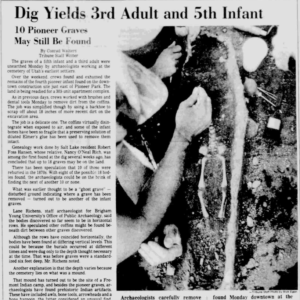
The Salt Lake Tribune reports on new remains discovered in the pioneer cemetery. (Utah Digital Newspapers)
Since the graves were identified as Mormon pioneers, they were given to the Church of Jesus Christ of Latter-day Saints, who arranged to have all the pioneer remains removed and reburied at This is the Place State Park.
According to the This is the Place website:
“The building project paused for quite some time while archaeologists from Brigham Young University’s Public Office of Archaeology undertook an excavation of the cemetery. The remains of those buried were sent to the University of Wyoming for testing and research, and upon their return the bones of 32 bodies were laid in separate coffins. The remains were relocated to This Is the Place Heritage Park on Memorial Day, 1987.
“Research indicates that the very first pioneers who died in the valley were buried in the cemetery unearthed by the construction crew.”
The indigenous remains pre-date the pioneer remains by almost 1,000 years. Three bodies of Native Americans were found, prepared for burials, and two pit houses were discovered dating back to the ancient Fremont Indians.
“The Piute and Goshute are hunter-gatherers, mobile groups,” Quist said. “The Ute were early adopters of the horse so they are all over the place. But [this is] before that time period, so we’re talking roughly, about 2,000 years ago, it’s called the Fremont Era. There was an established village settlement in Salt Lake.”
The indigenous remains were given back to tribes.
“Native American remains take a different path and in this case they were repatriated to a local tribe. I don’t know which tribe though because that was not in the report,” Quist said. “That’s the correct and legal thing to do. They’re repatriated to the tribe, sometimes it’s a group of tribes and they collectively determine amongst themselves what will then happen. And we are not privy to that information.”
The return of indigenous remains is done in a formal process with respect with as much publicity or as little publicity as the tribes desire. In this case, little information is known about what happened to the indigenous remains other than three bodies found were returned to the tribes.
So you might be thinking, “OK bodies were found there, but then relocated, what’s the big deal?”
Well here’s where it gets “Poltergeist” movie-style creepy. Archaeologists had very limited time to complete the excavation.
“They had three weeks to do the excavation which is not very long especially when they’re dealing with human remains, especially child human remains,” Quist said.
I asked Quist what the chances were of remains being left behind.
“Oh I think very high. The archaeologists at the end of their allotted two, three weeks of excavation were pretty adamant that they thought there were other indigenous remains present,” Quist said.
Despite those concerns, construction continued anyway.
Robinson Hill said although there is a small plaque in the corner of block, tenants may have no idea what they’re living on top of.

A plaque mentioning the pioneer cemetery and Native American burial ground on the corner of 300 South and 200 West. (Eliza Pace, KSL TV)
“We’re still finding artifacts in this area, so there’s probably remains still around here,” Robinson Hill said. “A lot of times, they do not disclose that information when it comes to indigenous burial grounds in urban settings or even cemeteries like in “Poltergeist,” they don’t disclose that information. People don’t know, ‘hey this used to be an old cemetery.’ ”
As we stood on the block, Quist showed me where these unmarked graves were based on the archaeology report. Meanwhile people walked in and out of the apartment building, some with their morning coffee, some with their pets headed out for a walk, with no idea what had been, and potentially still remained, beneath the surface.
Liberty Crest Apartments
The Liberty Crest Apartments, built on what was formerly a Scandinavian Methodist Episcopal church, was also the home of one of Salt Lake’s first serial killers, Reverend Frances Hermann.
The church sat at 158 S. 200 East in Salt Lake City, the location of Liberty Crest Apartments now.
Hermann who was a well-known pastor in Scandinavian social circles lived in several other states before moving to Salt Lake City in 1895.
“So the Reverend lived in the church, there was kind of a housing unit associated with it, but also a Mr. John M. Hanson, he resided in the second story apartment in the church and he was on the board of trustees,” Quist said. “He was always pretty suspect of the reverend.”
Hermann was known to be close to a 25-year-old Swedish immigrant named, Henrietta Clausen also spelled Clawson by some sources.
“The last time Miss Clausen was seen alive was in the company of the Reverend,” Quist said. “Hansen, the trustee and his wife – they were suspicious since their good friend, Miss Henrietta Clausen, who was a young Swedish immigrant had gone missing.”
Clausen was last seen Sept. 29, 1895 and then disappeared.“She was well known to have been madly in love with him and had been sleeping in his study,” Quist said. “Now the reverend of course denied any improper behavior.”
Apparently Clausen had confided in a friend that he’d proposed marriage to her, that she was pregnant and she had been sleeping in his quarters in the church.
“He certainly had pursued her…” Quist said. “Although I think the cover story was she was his housekeeper.”
When asked about her disappearance, the Hermann said she had “propositioned him” and he in turn rebuked her.
“He said because of his rebuff of her, she must have left the state, and that’s why nobody had seen her,” Quist said.
On Sept. 30, 1895, Hermann had the janitor of the church, only identified as “Johnson,” clean out the furnace in the basement of the church for a fire. The furnace had previously been used to warm the church, but because of a fire that nearly destroyed the building years before, was no longer used.
John M. Hanson who resided in the second story of the church observed that soon after that, Hermann lit a large fire in the furnace accompanied by a terrible stench.
It wasn’t until months later, sometime around May 1896, that Hanson investigated the basement of the church. Hanson found a knife blade, a garter buckle, corset steel, a belt buckle, two straight razors, and several human bones in the Church’s ash grate.
After the human remains were discovered, police became involved and made an even more harrowing discovery: the decomposing torso of Clausen buried in a corner of the church’s dirt floor basement.
Items also recovered by police included bloody overalls of the Reverend found in a bloody barrel, and two false teeth from Clausen.
“They didn’t have real dental records way back then, but they did have a dentist here in Salt Lake who remembered putting in, or working on her mouth and installing those teeth for her,” Quist said. “That’s how they identified the body as being Miss Clausen.”
The door of the furnace was smeared with blood and at 10 inches by 6 inches, was a small opening to fit a body into.
“The police believed that the barrel was used as a butcher block to dismember the body so that at least parts of it would fit into the furnace.”
Police searched two trunks in Hermann’s study and found items belonging to Clausen and another missing Swedish immigrant, Annie Samuelson.
“So now they’ve got two victims,” Quist said. “The police also found bottles of poison, chloroform, which is what I suspect he used, and other drugs, some of which produced abortions and they were found in reverend’s study.”
“Now Miss Samuelson had an aunt living here locally and the aunt admitted to her niece having ‘improper relations,’ ” Quist said. “Her aunt said that the reverend had performed an abortion shortly before her disappearance.”
At that point it was 30 to 40 years in prison if a doctor was caught for providing an abortion, and anyone considered an accomplice to an abortion also could serve jail time.
“According to members of the church, Miss Clausen, after she had gone missing, that’s when Annie Samuelson became the reverend’s favorite. She went missing in January.”
Soon after she went missing Hermann pawned her gold watch and ring.
“So police suspected that Annie Samuelson had also been poisoned by the reverend, her body dismembered, and either burned or buried elsewhere because he was also known to take midnight rides in his carriage out into the country,” Quist said.
The city was shocked and the story was widely circulated, first in Salt Lake and then reaching headlines in papers in San Francisco and Arizona. The Salt Lake Herald reported the story with the headline, “Sanctuary of God defiled with blood” on May 23, 1896.
“Since then the Salt Lake readers were just enthralled and followed this for like the next several months” Quist said.
“It was also found that the reverend embezzled $7,000 of church funds so that’s around $300,000 today, a lot of money,” Quist said.
Here’s where it gets really interesting or just really creepy.
“He [Hermann] had been married three times before and in each instance his wife died under mysterious circumstances and two of his three children also died in unusual circumstances,” Quist said.
Quist and Robinson Hill say there are likely multiple other victims.
“The pattern with serial killers is one, two, if there’s two then there’s a likelihood of more. You don’t just start with one, and you don’t just start with two because then they’re like, ‘I know how to do this,’ ” Robinson Hill said.
Hermann never returned to Salt Lake City and was never charged for his crimes.
The church fell into disrepair and was eventually torn down in 1906, mostly due to the memory of the heinous crimes committed on the premises. The Liberty Crest Apartments remain — standing over the ground where a dismembered and decomposing torso was once found.
The residence of a vicious serial killer who was never apprehended, is now home to hundreds of people.


